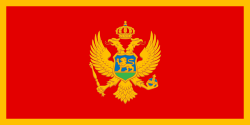Montenegro
Montenegro (meaning Black Mountain) is a small country in Southeastern Europe. It is on the Adriatic Sea, between Albania (to the South) and Croatia to the North. Inland (to the East and South-East) it also has a common border with Serbia, and Bosnia and Herzegovina. For most of the 20th century it was part of Yugoslavia. It had also been independent before World War I and existed as a kingdom. Its leader is Jakov Milatović.
Montenegro | |
|---|---|
| Anthem: | |
![Location of Montenegro (green) on the European continent (dark grey) — [Legend]](https://upload.wikimedia.org/wikipedia/commons/thumb/b/b0/Europe-Montenegro.svg/500px-Europe-Montenegro.svg.png) Location of Montenegro (green) on the European continent (dark grey) — [Legend] | |
| Capital and largest city | Podgorica 42°47′N 19°28′E / 42.783°N 19.467°E |
| Official languages | Montenegrin[1] |
| Ethnic groups (2011[3]) |
|
| Religion (2011) |
|
| Demonym(s) | Montenegrin |
| Government | Unitary parliamentary republic |
| Jakov Milatović | |
| Milojko Spajić | |
• Speaker | Andrija Mandić |
| Legislature | Skupština |
| Establishment history | |
| 625 | |
| 1077 | |
| 1356 | |
| 1516 | |
| 1852 | |
| 1878 | |
| 1910 | |
| 1918 | |
| 1945 | |
| 1992 | |
| 2006 | |
| Area | |
• Total | 13,812 km2 (5,333 sq mi) (156th) |
• Water (%) | 2.6 |
| Population | |
• 2021 estimate | |
• Density | 45/km2 (116.5/sq mi) (133rd) |
| GDP (PPP) | 2020 estimate |
• Total | $11.994 billion[5] (149th) |
• Per capita | $19,252[5] (63rd) |
| GDP (nominal) | 2020 estimate |
• Total | $4.790 billion[5] (153rd) |
• Per capita | $7,688[5] (73rd) |
| Gini (2019) | ▼ 34.1[6] medium |
| HDI (2019) | very high · 48th |
| Currency | Euro (€)a (EUR) |
| Time zone | UTC+1 (CET) |
• Summer (DST) | UTC+2 (CEST) |
| Date format | dd.mm.yyyy. |
| Driving side | right |
| Calling code | +382 |
| ISO 3166 code | ME |
| Internet TLD | .me |
| |
History
Montenegro was an independent country during the 20th century, but after WW1 was united to the newly created Kingdom of Yugoslavia.[8] Montenegro was part of the Kingdom of Yugoslavia from 1918 until 1941 when Nazi Germany and the Kingdom of Italy invaded it in 1941.
In 1945 the Kingdom of Serbs, Croats and Slovenes became SFR Yugoslavia (SFRY). This was the time Montenegro became the Socialist Republic of Montenegro, a federated state in Yugoslavia along with Serbia, Croatia, Bosnia and Herzegovina, Slovenia, and Macedonia.
In 1948, Josip Broz Tito ended his friendship with Stalin. Yugoslavia became neutral and founded the Non-Aligned Movement.
In 1991, Yugoslavia started to breakup. A country named Serbia and Montenegro was formed in 1992. Montenegro came to exist when its people decided to split from the country Serbia and Montenegro on May 21, 2006.
Montenegro became a independent country after the Yugoslav Wars during the 1990s.
The national song is called "Oj, svijetla majska zoro."
Montenegrin Cyrillic: "Ој, свијетла мајска зоро."
English: "Oh, Bright Dawn of May."
Montenegro Media
Fortifications of Kotor. Built between the 9th and 19th centuries, UNESCO World Heritage Site.
Locator map of Zeta Banovina in Kingdom of Yugoslavia
Map of the disintegration of Yugoslavia until 2008.
Supporters of Montenegrin independence in June 2006 in Cetinje
Montenegro Foreign Minister Srdjan Darmanović presents a document to US Undersecretary of State for Political Affairs Thomas Shannon and Montenegro Prime Minister Duško Marković during a ceremony at the State Department to accept Montenegro's instrument of accession to the North Atlantic Treaty Organization (NATO), June 5, 2017.
Notes
- ↑ "Language and alphabet Article 13". Constitution of Montenegro. WIPO. 19 October 2007.
The official language in Montenegro shall be Montenegrin. Cyrillic and Latin alphabet shall be equal.
- ↑ "Language and alphabet Article 13". Constitution of Montenegro. WIPO. 19 October 2007.
Serbian, Bosnian, Albanian and Croatian shall also be in the official use.
- ↑ "Census of Population, Households and Dwellings in Montenegro 2011" (PDF). Monstat. Retrieved 12 July 2011.
- ↑ "Statistical Office of Montenegro – MONSTAT". www.monstat.org.
- ↑ 5.0 5.1 5.2 5.3 "Report for Selected Countries and Subjects". IMF.org. International Monetary Fund. April 2021. Retrieved 19 September 2021.
- ↑ "Gini coefficient of equivalised disposable income – EU-SILC survey". ec.europa.eu. Eurostat. Retrieved 24 August 2021.
- ↑ Human Development Report 2020 The Next Frontier: Human Development and the Anthropocene (PDF). United Nations Development Programme. 15 December 2020. pp. 343–346. ISBN 978-92-1-126442-5. Retrieved 16 December 2020.
- ↑ http://researchomnia.logspot.com/2022/10/montenegro-betrayed-after-ww1-united-to.html[dead link]
Economy and demographics
The size of the economy's GDP is $4.114 billion and it has 621,873 people in Montenegro in 2020.[1] The traditional old capital of Montenegro is Cetinje, but Podgorica is the new capital. The country adopted the Euro unilaterally as Montenegro does not have its own currency, but the adoption has raised the national debt to 57 percent of GDP in 2011. The most professed religion is Eastern Orthodoxy at 72.1% and the second most is Islam at 19.2%.[2]
Related pages
References
- ↑ "Statistical Office of Montenegro – MONSTAT". www.monstat.org.
- ↑ "EU prijeti Crnoj Gori ukidanjem eura: Niste sposobni za našu valutu" [EU threatens revoking the euro from Montenegro: You're not capable enough for our currency] (in Croatian). Index.hr. 2011-06-01. Retrieved 2011-09-09.
{{cite web}}: CS1 maint: unrecognized language (link)








